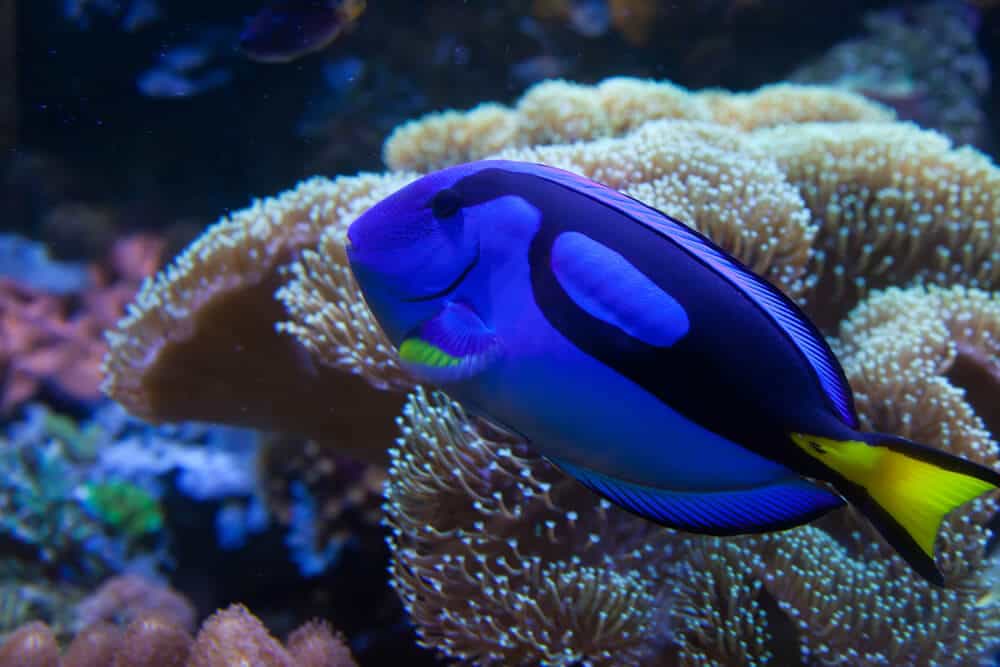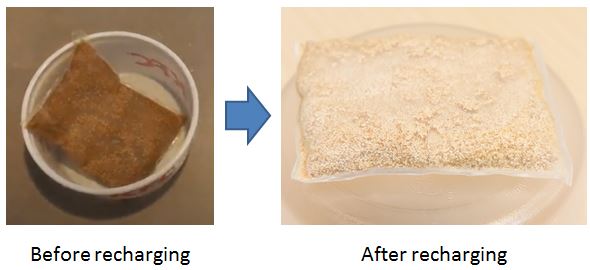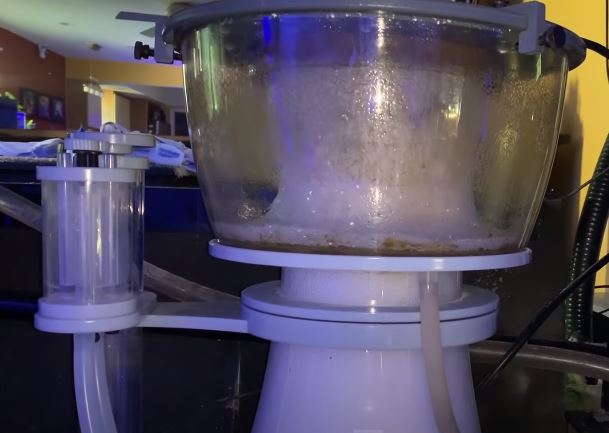If you own a saltwater aquarium, then the chances are that you have heard the words protein skimmer before. Maybe it was called something else like foam fractionator, regardless of the name you know it as, it is an essential part of a saltwater aquarium.

In this article, you will get to understand what a protein skimmer is, its functions, and whether you need it for a successful aquarium.
Read on to know more about this amazing filtration system for your saltwater aquatic ecosystem.
Contents
- What is a protein skimmer, and what does it do?
- How does a Protein Skimmer Work?
- Do You Really Need a Protein Skimmer for a Successful Reef Tank?
- Protein skimmer FAQs
- Will a protein skimmer help with algae?
- Can I use a protein skimmer for a freshwater tank?
- Do I need protein skimmer with a canister filter?
- Do I need protein skimmer for a Fowlr tank?
- Is a protein skimmer necessary for a nano reef?
- Do I need a protein skimmer for anemones?
- How big of a protein skimmer do I need?
- Conclusion
What is a protein skimmer, and what does it do?
In the simplest terms, protein skimmer, also known as a foam fractionator, is a device used in saltwater aquariums in the removal of organic wastes, which include fish excrement, undigested food, and proteins. The other main purpose of using protein skimmer is to increase aeration in your aquarium with the removal of organic matter. In other words, protein skimmer allows your fish to get adequate oxygen.
There are several brands and designs of protein skimmers available on the market, and the type you choose depends on your aquarium needs.
Read our full article about How to choose the right protein skimmer for your tank
How does a Protein Skimmer Work?
There’s a lot of technical jargon on how a protein skimmer works but I don’t want to bore you so I’ll be as basic as possible.
A lot of you have probably been to a beach at least once and you might have noticed that there was a foam-like substance washed on the shore by the waves.
Yes, that’s the ocean filtering out its own waste by mixing air and water alongside decayed materials and dissolved organic waste in the ocean. And that is what ends up on the beach as foam.
Simple, isn’t it?
The same happens with a protein skimmer in a saltwater aquarium.
So how does a protein skimmer work?
The protein skimmer uses a pump mechanism to mix air and water to create this foam but this foam isn’t washed across any beach, rather it is collected in a cup that you clean up when it gets full.
That’s cool, right?
But I want you to understand something.
The protein skimmer isn’t capable of removing all the contaminants in your aquarium but it removes most of it.
While most contaminants are hydrophilic, which means they love water and are water soluble, some contaminants are hydrophobic, they repel water and do not work too well with protein skimmers. These are usually oils from various sources.
These hydrophobic contaminant usually causes the protein skimmer to produce very low or no amounts of foam for a few hours. So I’ll give you this tip. Try using activated carbon. It helps a lot in removing these oils.
Watch the below video for more details.
Do You Really Need a Protein Skimmer for a Successful Reef Tank?
To understand whether or not you need a Protein Skimmer to maintain a successful reef tank, you need to understand why you might need one and why it is better than standard filtering.
Waste Problem
Every day, in your efforts to feed your small aquatic ecosystem and maintain the tank, you pollute the water with additives and even the remnants of the foods.
Some of these foods will be consumed by the fishes, crabs and other aquatic life in your aquarium. However, the end result of this is a polluted tank with substances like phosphate, nitrate, toxins, coloring and even odor in some cases.
Also, most of the food given to your fish is not consumed by them, and these left-overs get broken down by bacteria and other micro-organisms in the tank.
Usually, the best way to control this problem of waste is to reduce the amount of food you give to your fish. However, it is well known that proper feeding is at the core of fish care. It, therefore, seems that adequate nutrition and increased pollution go hand and hand.
Yeah, but I Can Perform Water Changes!
It is true that a lot of people perform water changes as a method of controlling the pollutants in aquarium water, and keeping waste debris low. But is it really as effective as protein skimming?
By removing some of the tank’s polluted water and replacing it with new saltwater, it is possible to keep the water pollutants in check. However, here are some of the problems with water change:
- By removing up to 30% of the water volume in your tank, it means you still have up to 70% of polluted water in your tank by the time you are done.
- Saltwater is not a cheap commodity.
- It is time-consuming.
This is where a protein skimmer comes in.
You can remove up to 50% of the organic compound and pollutants in your water and still maintain a healthy water cycle while requiring less water change.
Why is Protein Skimmer A Good Investment?
First, the speed of protein skimmers is quite impressive. Before organic compounds are broken down into unwanted nutrients, protein skimmer removes up to half of these compounds. This means there is a reduced need for you to carry out water change as frequently as when you don’t have a protein skimmer.
When you carry out water change, it means food substances and denser particulate matter can get stuck at the bottom of your aquarium’s reef and keep decomposing.
However, with the use of a protein skimmer, what you get is the removal of molecular-sized particles and even the disintegration of larger ones into molecules. Protein skimmer is quite effective at removing particles from the water and leaving minimal residue when compared to water change.
With protein skimmer, even the tiny particulate matter that cannot be filtered out with the use of a mechanical filtration system will be dissolved and removed.
The Other Benefits of Using Protein Skimmer
One primary function that no water change or typical mechanical filtration system can perform is gas exchange. Wait, What?
So, you see, when your fish consumes the available oxygen in the water, there needs to be a replacement of that oxygen, as well as a means of releasing carbon dioxide (CO2). A protein skimmer promotes proper gas exchange by helping to turn the water surface over with the use of its surface area and pump system.
Here are some of the benefits in bullet points for simplicity:
- It reduces the amount of phosphate in your aquarium, therefore, preventing aggressive nuisance algae growth.
- It also helps to remove biological toxins that are released from the corals, algae, and the invertebrates in the water.
- By reducing the build-up of carbon dioxide in the water, the pH level of the water can be maintained (a critical factor for a successful aquarium).
Final Answer
The truth is that if you are serious about having a successful aquarium, then you need to have a reliable method of nutrient control. It turns out protein skimmer is just one of those methods and a great one at that.
So, here is a summary of what we think.
If you don’t want to spend a lot of time maintaining your tank with processes like water changes and have more time actually admiring the fish in your tank, then you need a protein skimmer.
However, you don’t need it if:
- You have a lot of free time on your hands and a lot of money to keep buying saltwater.
- Water change is actually an exciting job for you. It’s alright, we don’t judge.
- Your coral is easy to take care of.
Protein skimmer FAQs
Will a protein skimmer help with algae?
Yes.
Protein skimmers can help prevent the growth of algae in your aquarium. They are capable of accomplishing this task by removing the organic waste in your tank before they can be broken down into phosphates.
Most aquarium owners, if not all, have had to fight against these relentless micro-organisms at least once. Protein skimmer will work to hinder the growth of algae and keep your tank water sterile and healthy for your aquatic life.
Can I use a protein skimmer for a freshwater tank?
The simple answer is yes, but protein skimmers are not recommended for freshwater tanks.
Protein skimmer, when used in a freshwater tank, will not produce satisfactory results as a biological filter will. The techniques employed by protein skimmers to sterilize a saltwater aquarium will not efficiently work on a freshwater aquarium.
A protein skimmer cleanses your tank by creating air bubbles or foams; organic waste then clings to these air bubbles before they float onto the surface and are retrieved.
Air bubbles cannot be easily created in freshwater. This will diminish the performance of your protein skimmer in your tank. Therefore, it is advisable to get a biological filter for your freshwater tank and not depend solely on a protein skimmer.
Do I need protein skimmer with a canister filter?
This is totally dependent on the type of aquarium.
A protein skimmer performs the job of a canister filter and more. It breaks down the waste in your aquarium and removes it before they can turn into harmful toxins. But only a protein skimmer cannot keep your aquarium clean, although this is dependent on the needs of your aquarium.
If you have a fish only tank, you need some kind of filtration system. You can, however, substitute a canister filter with live rocks. Live rocks don’t only serve as a biological filter. They can also beautify your aquarium and provide shelter for your aquatic life.
The point is that you need a protein skimmer and another sort of filtration device for your tank.
Do I need protein skimmer for a Fowlr tank?
A protein skimmer is recommended for Fowlr tanks.
The term Fowlr tank is used to refer to an aquarium which contains fishes only and live rocks. While this type of saltwater tank requires a high-quality filtration system, a protein skimmer is also needed to reduce waste and keep bacteria at bay.
Although manually changing the water in your aquarium will get you the same result as a protein skimmer, this task will, however, prove to be more difficult and time-consuming. With a protein skimmer, you can easily increase the water quality of your Fowlr tank without having to break a sweat.
It should be noted that it is best to select a protein skimmer that can process up to 1.5 times of water per hour for notable results.
Is a protein skimmer necessary for a nano reef?
Yes, a protein skimmer is essential for a nano reef tank.
You wouldn’t have to look hard to see the allure of a nano reef tank.
It is like having your own personal ocean.
This beautiful saltwater aquarium is hard to maintain mainly due to its compact size. They hold a small volume of water, and any problem with the water quality can become critical in a second.
While having a protein skimmer in your nano reef is not compulsory, it can help guarantee the smooth running of your tank. This equipment will work consistently to ensure any waste threatening the water quality of your tank is quickly disposed of.
Do I need a protein skimmer for anemones?
It is advisable to have a protein skimmer for your anemones.
Anemones are delicate creatures that require clean water, sufficient lighting, and regular feeding to thrive in an aquarium. Any living arrangement not up to this standard would negatively affect their health, and before you perceive any change, it might be too late.
You can decide not to have a protein skimmer in a tank riddled with anemones, but it would be beneficial to have one.
Skimmers will help create a habitable environment for your anemones. Using protein skimmers is stress-free as opposed to having to change your water frequently.
How big of a protein skimmer do I need?
One of the essential features to consider before purchasing a protein skimmer is its size. Manufacturers of protein skimmers will usually state the size of the tank suitable for the skimmer. Also, consider your aquarium’s water volume and ensure the rated air intake capacity of the protein skimmer is sufficient enough for the size of your tank.
Crowded aquariums with a vast number of aquatic life will typically require a large protein skimmer.
However, a protein skimmer that is too big for your aquarium can do more harm than good. An oversized skimmer will not run adequately, and the result of this will be a half clean tank.
Conclusion
Every day, new methods of caring for your aquarium are introduced, and it can be a difficult task to differentiate between what is relevant and what is not. The answers provided to the questions above will give you an insight on how to care for your aquarium.
Now, if you are convinced that your aquarium needs a protein skimmer, there are certain factors you must consider in order to select the right one. Click here to learn how to choose a protein skimmer for your tank.






